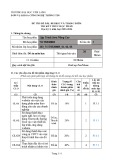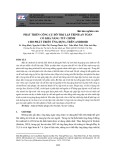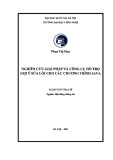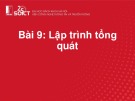Lecture 6:
Collections
1
Concept
A collection is a data structure – actually, an object – to hold other objects, which let you store and organize objects in useful ways for efficient access
Check out the java.util package! Lots of interfaces and classes providing a general collection framework. Programmers may also provide implementations specific to their own requirements
Overview of the interfaces and concrete classes in the collection
framework
Collection
Map
Iterator
HashMap
List
Set
ListIterator
SortedMap
WeakHashMap
ArrayList
SortedSet
HashSet
TreeMap
LinkedList
TreeSet
2
Root interface – Collection (1)
Methods working with an individual collection
public int size() public boolean isEmpty() public boolean contains(Object elem) public boolean add(Object elem)
Depends on whether the collection allows duplicates
public boolean remove(Object elem) public boolean equals(Object o) public int hashCode() public Iterator iterator() public Object[] toArray()
Returns a new array containing references to all the elements of the
collection
public Object[] toArray(Object[] dest)
What is returned depends on whether the elements in the collection fit in
dest
If the type of dest is not compatible with the types of all elements in the
collection, an exception is thrown
3
Root interface – Collection (2)
Primary methods operating in bulk from another collection public boolean containsAll(Collection coll) public boolean addAll(Collection coll)
Returns true if any addition succeeds
public boolean removeAll(Collection coll)
Returns true if any removal succeeds
public boolean retainAll(Collection coll)
Removes from the collection all elements that are not elements of coll
public void clear()
Remove all elements from this collection
The SDK does NOT provide any direct implementations of the
Collection interface Most of the actual collection types implement this interface, usually by
implementing an extended interface such as Set or List This interface is typically used to pass collections around and
manipulate them where maximum generality is desired.
4
Iteration - Iterator
The Collection interface defines an iterator method to
return an object implementing the Iterator interface. It can access the elements in a collection without exposing its internal
There are NO guarantees concerning the order in which the elements
structure.
Three defined methods in Iterator interface
public boolean hasNext() – returns true if the iteration has more
are returned
public Object next() – returns the next element in the iteration
An exception will be thrown if there is no next element What’s returned is an Object object. You may need special casting!
public void remove() – remove from the collection the element
elements
can be called only once per call of next, otherwise an exception is
thrown
last returned by the iteration
5
classical routine of using iterator:
public void removeLongStrings (Collection coll, int
maxLen) {
Iterator it = coll.iterator(); while ( it.hasNext() ) {
String str = (String)it.next(); if (str.length() > maxLen) it.remove()
}
}
6
Iteration - ListIterator
ListerIterator interface extends Iterator interface. It adds methods to manipulate an ordered List object during iteration
Methods
public boolean hasNext()/ public boolean hasPrevious() public Object next()/ public Object previous() public Object nextIndex()/ public Object previousIndex()
When it’s at the end of the list, nextIndex() will return list.size() When it’s at the beginning of the list, previousIndex() will return -1 public void remove() – remove the element last returned by next() or
public void add(Object o)– insert the object o into the list in front of the next element that would be returned by next(), or at the end if no next element exists
public void set(Object o) – set the element last returned by next() or
previous()
previous() with o
7
Potential problem of Iterator/ListIterator
They do NOT provide the snapshot guarantee – if the content of the collection is modified when the iterator is in use, it can affect the values returned by the methods
import java.util.*;
public class IteratorTest { public static void main (String args[]) { ArrayList a = new ArrayList(); a.add("1"); a.add("2"); a.add("3");
Iterator it = a.iterator(); while(it.hasNext()) { String s = (String)(it.next()); if(s.equals(“1")) { a.set(2,“changed"); }
System.out.println(s); } } }
Output? 1 2 changed
8
Potential problem of Iterator/ListIterator (cont.)
A snapshot will return the elements as they were when the Iterator/ListIterator object was created, which is unchangeable in the future
If you really need a snapshot, you can make a simple copy of
the collection
Many of the iterators defined in the java.util package are in
the type of fail-fast iterators
They detect when a collection has been modified
When a modification is detected, other than risk performing an
action whose behavior may be unsafe, they fail quickly and cleanly by throwing an exception – ConcurrentModificationException
9
import java.util.*;
public class IteratorTest2 { public static void main (String args[]) { ArrayList a = new ArrayList(); a.add(“1”); a.add(“2”); a.add(“3”);
Iterator it = a.iterator(); a.add(“4”);
%> javac IteratorTest2.java %> java IteratorTest2
Exception in thread “main” java.util.ConcurrentModificationException
while(it.hasNext()) { String s = (String)(it.next()); System.out.println(s); } } }
10
List A List is an ordered Collection which allows duplicate elements. Its element indices range from 0 to (list.size()- 1) It adds several methods for an ordered collection The interface List is implemented by two classes
1.
ArrayList: a resizable-array implementation of the List interface
Adding or removing elements at the end, or getting an element at a specific position is simple – O(1) Adding or removing element from the middle is more expensive – O(n-i) Can be efficiently scanned by using the indices without creating an Iterator object, so it’s good for a list which will be scanned frequently
2.
LinkedList: a doubly-linked list
Getting an element at position i is more expensive – O(i) A good base for lists where most of the actions are not at the end
An example of using LinkedList (output)
11
Set and SortedSet
The Set interface provides a more specific contract for its methods, but adding no new methods of its own. A Set is a Collection that contains UNIQUE elements.
The SortedSet extends Set to specify an additional contract – iterators on such a set will always return the elements in a specified order By default it will be the elements’ natural order which is determined by
You can specify a Comparator object to order the elements instead
the implementation of Comparable interface
There are two implementations of Set in the collection framework HashSet – a Set implemented using a hashtable TreeSet – a SortedSet implemented in a balanced tree structure
An example of using a HashSet
of the natural order
12
Map and SortedMap
The Map interface does not extend Collection interface because a Map contains key-value pairs, not only keys. Duplicate keys are not allowed in a Map. It’s implemented by classes HashMap and TreeMap.
There are methods to view the map using collections. For example: public Set keySet() and public Collection values(). The collections returned by these methods are backed by the Map, so
removing an element from one these collections removes the corresponding key/value pair from the map You cannot add elements to these collections If you iterate through the key or value sets, they may return values from
Interface SortedMap extends Map and maintains its keys in sorted
order. Class TreeMap implements SortedMap.
An example using HashMap
their respective sets in any order
13
Synchronized wrappers and the Collections class (1)
The Collections class contains static utility methods which can be roughly classified into two groups: those provide wrapped collections and those don’t.
All the collection implementations provided in java.util we’ve
seen so far are unsynchronized
concurrent access to a Collection by multiple threads could cause
you can use synchronization wrappers for those collections that might
indeterminate results or fatal errors.
Methods in the Collections class to get a synchronized wrapper
Collection synchronizedCollection(Collection c) Set synchronizedSet(Set s) SortedSet synchronizedSortedSet(SortedSet s) List synchronizedList(List l) Map synchronizedMap(Map m) SortedMap synchronizedSortedMap(SortedMap m)
be accessed by multiple threads to prevent potential threading problems.
14
Synchronized wrappers and the Collections class (2)
The above methods return wrappers whose methods are fully synchronized, and so are safe to use from multiple threads
Example Map unSyncMap = new HashMap(); Map syncMap = Collections.synchronizedMap(unSyncMap);
unSyncMap
HashMap
elements
synchronized wrapper
syncMap
synchMap has all relevant methods synchronized, passing all calls
there is actually only one map, but with two different views. So
through to the wrapped map (unSynchMap)
the wrapper synchronizes on itself, so you can use syncMap to
modifications on either map is visible to the other
synchronized (syncMap) {
for (int i=0; i< keys.length; i++)
unSyncMap.put ( keys[i], values[i] );
}
synchronize access, and then use unsyncMap safely inside such code
15
Unmodifiable wrappers and the Collections class (1)
The Collections class contains a set of methods that return
unmodifiable wrappers for collections: attempts to modify the returned set, whether direct or via its iterator, result in an UnsupportedOperationException The contents of an unmodifiable wrapper can change, but can only through
Six methods to return unmodifable wrappers:
Collection unmodifiableCollection(Collection c) Set unmodifiableSet(Set s) SortedSet unmodifiableSortedSet(SortedSet s) List unmodifiableList(List l) Map unmodifiableMap(Map m) SortedMap unmodifiableSortedMap(SortedMap m)
the original collection, not through the wrapper itself
16
Unmodifiable wrappers and the Collections class (2)
Example Original: it’s dangerous that the array’s content can be changed
public String suits[]= {
“Hearts”, “Clubs”, “Diamonds”, “Spades” };
Using the unmodifiable wrapper to prevent the danger:
private String suitsNames[] = {
“Hearts”, “Clubs”, “Diamonds”, “Spades” };
public final List suits = Collections.unmodifiableList(Arrays.asList(suitNames) ;
others, while the read-write access is still available to the code itself by retaining a reference to the wrapped collection (the original collection)
The unmodifiable wrapper offers read-only access to
17
Abstract implementations
The collection framework provides a set of abstract implementations for you to design your own implementation of relevant collection interfaces to satisfy your particular needs
The set of abstract classes: AbstractCollection AbstractSet AbstractList AbstractSequentialList AbstractMap
18
The legacy collection types
The package java.util contains some other legacy collections than those we just learned. They are still in wide use in existing code and will continue to be used until programmers shift over to the new types
The set of legacy collections
Enumeration – analogous to Iterator Vector – analogous to ArrayList Stack – a subclass of Vector Dictionary – analogous to Map interface Hashtable – analogous to HashMap Properties – a subclass of HashTable
19




































